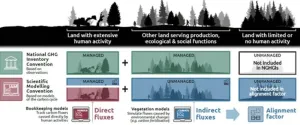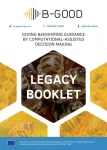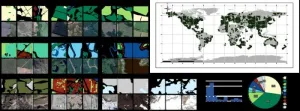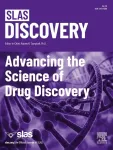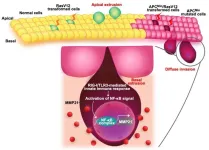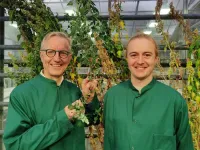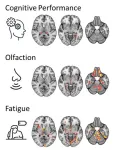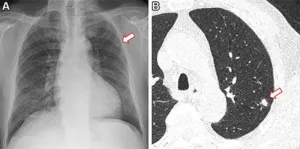(Press-News.org) Effective management of land, whether for agriculture, forests, or settlements, plays a crucial role in addressing climate change and achieving future climate targets. Land use strategies to mitigate climate change include stopping deforestation, along with enhancing forest management efforts. Countries have recognized the importance of the land use, land-use change, and forestry (LULUCF) sector, with 118 of 143 countries including land-based emissions reductions and removals in their Nationally Determined Contributions (NDCs), which are at the heart of the Paris Agreement and the achievement of its long-term goals.
A new study, published in Nature, demonstrates that estimates of current land-based emissions vary between scientific models and national greenhouse gas inventories due to differing definitions of what qualifies as "managed" land and human-induced, or anthropogenic, removals on that land, and shows how global mitigation benchmarks change when accounting for LULUCF fluxes in scientific models from the national inventory perspective. The research team underscores the necessity to compare like for like when assessing progress towards the Paris Agreement with countries needing to achieve more ambitious climate action when comparing their national starting points with global models.
“Countries estimate their LULUCF fluxes (emissions and removals) differently. Direct fluxes are a result of direct human intervention, such as agriculture and forest harvest. The models in the Assessment Reports by the Intergovernmental Panel on Climate Change (IPCC) use this accounting approach to determine the remaining carbon budget and the timing for achieving net-zero emissions. Indirect fluxes are the response of land to indirect human-induced environmental changes, such as increase in atmospheric CO2 or nitrogen deposition that both enhance carbon removal,” explains Giacomo Grassi, a study coauthor and researcher with the Joint Research Centre at the European Commission.
Grassi points out that it is practically not possible to separate direct and indirect fluxes through observations such as national forest inventories or remote sensing. Therefore, national greenhouse gas inventory methods follow reporting conventions that define anthropogenic fluxes using an area-based approach, whereby all fluxes occurring on managed land are considered anthropogenic. In contrast, greenhouse gas fluxes on unmanaged land are not included in the reporting.
Globally, this results in a difference between bookkeeping models and country inventories of around 4-7 gigatons of CO2, or around 10% of today’s greenhouse gas emissions, but this difference varies from country to country.
The research team assessed key mitigation benchmarks using the inventory-based LULUCF accounting approach. They found that, in pathways achieving the 1.5 °C long-term temperature goal of the Paris Agreement, net-zero CO2 emissions is achieved one to five years earlier, emission reductions by 2030 need to be 3.5-6% stronger, and cumulative CO2 emissions are between 55-95 Gt CO2 less. The research team emphasizes that results do not conflict with the benchmarks assessed by the IPCC, but rather assesses the same kinds of benchmarks using an inventory-based approach.
“The IPCC Assessment Reports use direct, land-based emissions as input and include the indirect emissions due to climate and environmental responses in their physical climate emulation to calculate the global temperature response to anthropogenic emissions. In our analysis, we make it clear that we’re looking at these two kinds of emissions separately. The climate outcome of each scenario we assess remains the same, but the benchmark – when viewed through the lens of national greenhouse gas inventory accounting conventions – shifts. Without making adjustments, countries could appear in a better position than they actually are,” explains Thomas Gasser, a study coauthor and senior researcher associated with both the IIASA Advancing Systems Analysis and Energy, Climate, and Environment programs.
“Our findings show the danger of comparing apples to oranges: To achieve the Paris Agreement, it’s critical that countries aim for the correct target. If countries achieve model-based benchmarks using inventory-based accounting, they will miss the mark,” says Matthew Gidden, study author and senior researcher in the IIASA Energy, Climate, and Environment Program.
Ahead of the COP28 summit and its first Global Stocktake – a process that will enable countries and other stakeholders to see where they’re collectively making progress toward meeting the goals of the Paris Agreement and where they’re not – the researchers are urging for more detailed national climate goals. They recommend distinct targets for land-based mitigation separate from actions in other sectors.
“Countries can bring clarity to their climate ambition by communicating their planned use of the LULUCF sector separately from emissions reductions elsewhere. While modelers and practitioner communities can come together to improve comparability between global pathways and national inventories, it is vital that the message that significant mitigation effort is needed this decade, is not lost in the details of reporting technicalities,” concludes Gidden.
Reference:
Gidden, M., Gasser, T., Grassi, G., Forsell, N., Janssens, I., Lamb, W., Minx, J., Nicholls Z., Steinhauser, J., Riahi, K. (2023). Aligning climate scenarios to emissions inventories shifts global benchmarks. Nature DOI: 10.1038/s41586-023-06724-y
Contacts:
Matthew Gidden
Senior Research Scholar
Sustainable Service Systems Research Group
Integrated Assessment and Climate Change Research Group
IIASA Energy, Climate, and Environment Program
gidden@iiasa.ac.at
Thomas Gasser
Senior Research Scholar
Integrated Assessment and Climate Change Research Group
IIASA Energy, Climate, and Environment Program
Exploratory Modeling of Human-natural Systems Research Group
IIASA Advancing Systems Analysis Program
gasser@iiasa.ac.at
Nicklas Forsell
Senior Research Scholar
Integrated Biosphere Futures Research Group
IIASA Biodiversity and Natural Resources Program
forsell@iiasa.ac.at
Keywan Riahi
Program Director and Principal Research Scholar
IIASA Energy, Climate, and Environment Program
riahi@iiasa.ac.at
About IIASA:
The International Institute for Applied Systems Analysis (IIASA) is an international scientific institute that conducts research into the critical issues of global environmental, economic, technological, and social change that we face in the twenty-first century. Our findings provide valuable options to policymakers to shape the future of our changing world. IIASA is independent and funded by prestigious research funding agencies in Africa, the Americas, Asia, and Europe. www.iiasa.ac.at
END
Mind the gap: Caution needed when assessing land emissions in the COP28 Global Stocktake
2023-11-22
ELSE PRESS RELEASES FROM THIS DATE:
Developing a new perspective for the EU beekeeping sector: B-GOOD legacy booklet
2023-11-22
The aim of the B-GOOD project (Giving Beekeeping Guidance By Computational-Assisted Decision Making) was to pave the way towards healthy and sustainable beekeeping within the European Union by following a collaborative and interdisciplinary approach. By merging data from within and around beehives, as well as wider socioeconomic conditions and by developing and testing innovative tools to perform risk assessments, B-GOOD provided guidance for beekeepers and helped them make better and more informed decisions.
The communication of scientific information and the transformation of scientific ...
How do temperature extremes influence the distribution of species?
2023-11-22
As the planet gets hotter, animal and plant species around the world will be faced with new, potentially unpredictable living conditions, which could alter ecosystems in unprecedented ways. A new study from McGill University researchers, in collaboration with researchers in Spain, Mexico, Portugal, Denmark, Australia, South Africa and other universities in Canada, investigates the importance of temperature in determining where animal species are currently found to better understand how a warming climate ...
New remote sensing dataset improves global land change tracking
2023-11-22
Tracking unprecedented changes in land use over the past century, global land cover maps provide key insights into the impact of human settlement on the environment. Researchers from Sun Yat-sen University created a large-scale remote sensing annotation dataset to support Earth observation research and provide new insight into the dynamic monitoring of global land cover.
In their study, published Oct 16 in the Journal of Remote Sensing, the team examined how global land use/landcover (LULC) has undergone dramatic changes with the advancement of industrialization and urbanization, including deforestation and flooding.
“We ...
A Special Collection collaboration between SLAS and SBI2
2023-11-22
Oak Brook, IL – The latest issue of SLAS Discovery is a joint Special Collection between SLAS and the Society of Biomolecular Imaging and Informatics (SBI2) to celebrate the 10th Annual SBI2 High-Content Imaging and Informatics meeting. This collaboration features a curated special collection of articles that highlight the significant impact of high-content imaging in basic and translational research. Volume 28, Issue 7 features one perspective, four original research articles and one short communication.
Perspective
Evolution and Impact of High Content Imaging
This ...
A new diagnostic tool to identify and treat pathological social withdrawal, Hikikomori
2023-11-22
Fukuoka, Japan—Researchers at Kyushu University have developed a new tool to help clinicians and researchers assess individuals for pathological social withdrawal, known as Hikikomori. The tool, called Hikikomori Diagnostic Evaluation, or HiDE, can be a practical guide on collecting information on this globally growing pathology.
Hikikomori is a condition characterized by sustained physical isolation or social withdrawal for a period exceeding six months. It was first defined in Japan in 1998, ...
Survival of the fittest? New study shows how cancer cells use cell competition to evade the body’s defenses
2023-11-22
Living cells compete with each other and try to adapt to the local environment. Cells that are unable to do so are eliminated eventually. This cellular competition is crucial as the surrounding normal epithelial cells use it to identify and eliminate mutant cancer cells. Studies have reported that when activating mutants of “Ras” proteins are expressed in mammalian epithelial cells, they are pushed toward the lumen, excreted along with other bodily waste, and eliminated by competition. Epithelial cells containing Ras mutants have been reported to be removed in this manner in several organs, including the small intestine, stomach, pancreas, and lungs. ...
Danish researchers puncture 100-year-old theory of odd little 'water balloons'
2023-11-22
Quinoa and many other extremely resilient plants are covered with strange balloon-like 'bladders' that for 127 years were believed to be responsible for protecting them from drought and salt. Research results from the University of Copenhagen reveal this not to be the case. These so-called bladder cells serve a completely different though important function. The finding makes it likely that even more resilient quinoa plants will now be able to be bred, which could lead to the much wider cultivation of this sustainable ...
Novel MRI reveals brain changes in long-COVID patients
2023-11-22
CHICAGO – People with long COVID exhibit patterns of changes in the brain that are different from fully recovered COVID-19 patients, according to research being presented next week at the annual meeting of the Radiological Society of North America (RSNA).
“To the best of our knowledge, this is the first study comparing patients with long COVID to both a group without history of COVID-19 and a group that went through a COVID-19 infection but is subjectively unimpaired,” said one of the study’s lead authors, Alexander Rau, M.D., resident in the Departments of Neuroradiology and Diagnostic and ...
AI identifies non-smokers at high risk for lung cancer
2023-11-22
CHICAGO – Using a routine chest X-ray image, an artificial intelligence (AI) tool can identify non-smokers who are at high risk for lung cancer, according to a study being presented next week at the annual meeting of the Radiological Society of North America (RSNA).
Lung cancer is the most common cause of cancer death. The American Cancer Society estimates about 238,340 new cases of lung cancer in the United States this year and 127,070 lung cancer deaths. Approximately 10-20% of lung cancers occur in “never-smokers” – people who have never smoked cigarettes ...
This sea worm’s butt swims away, and now scientists know how
2023-11-22
A research team, led by Professor Toru Miura from the University of Tokyo, shows how the expression of developmental genes in the Japanese green syllid worms, Megasyllis nipponica, helps form their swimming reproductive unit called stolon.
Life always finds ways to surprise us. The presence of a unique reproductive mechanism of some annelid worms or segmented worms is one such surprise. In a process called stolonization, the posterior body part with gonads of the syllid worm detaches from its original body. The detached part is called the stolon, and it is full of gametes (eggs or sperms). The stolon swims around by itself and spawns when it ...
